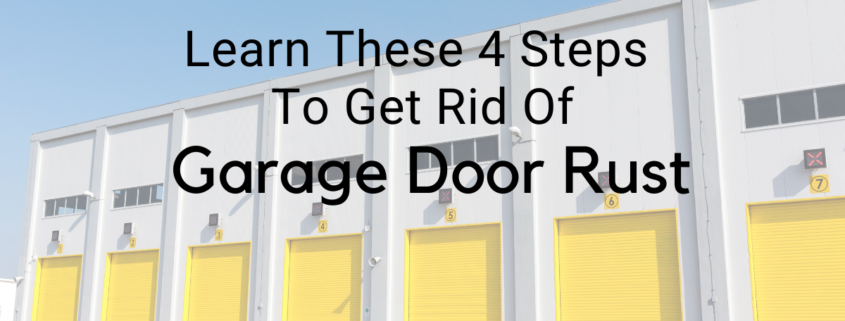Learn These 4 Steps to Get Rid of Garage Door Rust
A garage door is like a double door that fits within a wall structure or frame and is more durable than sheet metal doors. It protects and secures your home, increases home value, and creates the first impression of your home. It is, however, not exempted from having rust that could lead to wearing out and worst—replacement.
Rust can spread not only to the garage door opener but the door itself, too. If you begin to see signs of rust, treat the issue right away to prevent it from spreading and being serious. Garage door rust isn’t only unpleasant but can lead to damage if not properly cleaned and taken care of.
Garage Door Rust: Causes and Effects
Rust is nature’s way of reacting to the environment and a form of corrosion. Moreover, rust can appear in anything that is made of iron, steel, or metal, especially if exposed to elements for longer periods and if not coated with rust-inhibitors.
Find out what could cause a metal garage door to start creating rust and its negative effect, too.
- Environmental issues can contribute to garage door rust. If you live in the mountains, near industrial areas, or in humid climates, you’ll likely have a tough time dealing with rust.
- If you live in coastal areas or in the snow belt, saltwater damage can cause rapid rusting of your doors.
- Another fast rust contributor is when your garage door is exposed to acid or other industrial chemicals.
- If your garage door lacks regular cleaning, dirt, dust, and grime will begin to accumulate due to impurities. Cleaning at least once a month can help alleviate rust issues.
- Pollens can also be mistaken for rust but they can also accelerate rusting. Don’t panic, just give a good wash to your garage door twice a month.
- The wrong type of paint can cause rust development. A high gloss paint that is easy to clean is necessary. Using a primer first will protect your door’s bottom layer and paint that has a solid protective layer can help prevent rust. Ensure that paint is evenly spread in all areas and parts of the door.
- Poor quality doors that are often inexpensive are more prone to rusting than good quality doors.
Rust can make the surfaces or components of your door become weaker. It can also cause holes in sheet metal, and interfere with electrical components. Therefore, rust will have an effect on the safety, durability, and effectiveness of your garage door and its components.
Getting Rid of Garage Door Rust
Clean first to stop the oxidation process from going any further. Rust can easily spread so here are a few simple steps to ward off the rust on your garage door.
- Eliminate rust by cleaning. Begin with closing your door first and preparing a bucket with warm water and nonabrasive soap. Using a large sponge, scrub the door from top to bottom. Get rid of any accumulated dirt, dust, pollen, or other debris onto your garage door. Then rinse all the soap and towel dry the door before going to the next process of removing garage door rust.
- Wipe all the rust-affected parts with a rag or cloth soaked in white vinegar and allow it to sit for 10 minutes. The vinegar reacts with rust, initiating it to disperse. You can use a steel wool pad for scrubbing off the rust on your door. For stains that are tough, you can use other cleaning agents like baking soda or bleach.
- Use sandpaper to sand the affected areas and fix the holes usually seen in the lower corners of garage doors or between panels. You can patch up smaller holes by using auto body filler to fill in the gaps. But if the holes are extensive, it’s best to ask for help from garage door specialists.
- The final step is to protect against future garage door rust. Make sure to use rust-resistant primer and paint to prevent further damage and preserve your door.
Seek Help From Professionals
Taking care of garage door rust right away will not only boost the curb appeal of your property but can save you from the hassles of replacement. Our professionals can assist you with any kinds of environmental issues affecting your garage doors, particularly those showing signs of rust.
Contact Overhead Door Company of the Inland Empire, for any commercial garage door services.




